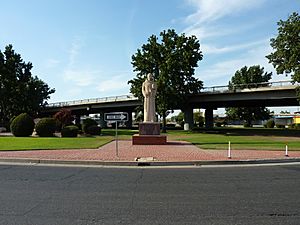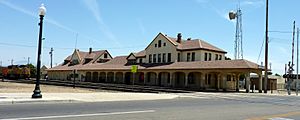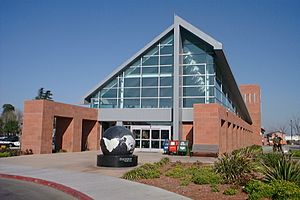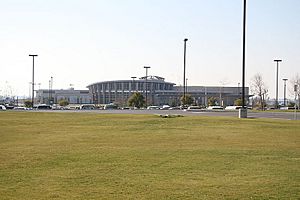Transportation in Kern County, California facts for kids
Kern County, located at the southern end of the San Joaquin Valley, has a very important transportation system. It's like an "unseen industry" because it helps move goods and people all over the place! Its location is perfect for shipping things west to the Central Coast, south to ports in Los Angeles, and east to connect with the rest of the country. It also links to all points north.
Contents
Highways Connecting Cities
Kern County has many highways, expressways, and freeways. It's easiest to think of them in three groups: main routes, alternate routes, and local routes. We can imagine Bakersfield as the center, with roads spreading out from there.
Main routes are the most important highways. They connect Bakersfield to big cities and other major transportation spots. Alternate routes also connect important places but offer a different way to get there, sometimes avoiding the main route. For example, SR 58 (Mojave Freeway) is a main route, but it's also part of an alternate way to get to I-5 (Golden State Freeway). This is because SR 58 and SR 14 are mostly freeways and can handle large trucks. Local routes are the other state roads. They mainly link smaller towns and rural areas to the main and alternate highways.
Even though Kern County is in the middle of a big interstate highway system, only one interstate, I-5, goes through it. Interestingly, I-5 bypasses many important places in the valley, like Fresno and Bakersfield, which are served by state routes like SR 99 and SR 58. There have been efforts to make SR 99 a future interstate, possibly I-7 or I-9. Caltrans and the Federal Highway Administration are working on upgrading it to interstate standards. SR 58 is also being turned into a freeway. If it becomes an interstate, it would be an extension of I-40, which currently ends in Barstow, CA. About 65% of trucks using SR 58 cross the California state line.
Main Highways
* means it's a freeway
 Westside Freeway* - Goes north to San Francisco, Sacramento, and the California state line.
Westside Freeway* - Goes north to San Francisco, Sacramento, and the California state line.
 Golden State Freeway* - Goes north to Fresno and Sacramento, and south to Los Angeles.
Golden State Freeway* - Goes north to Fresno and Sacramento, and south to Los Angeles. State Route 41 - Goes north to Fresno and Yosemite, and south to the Central Coast.
State Route 41 - Goes north to Fresno and Yosemite, and south to the Central Coast. Paso Robles Highway - Goes west to the Central Coast.
Paso Robles Highway - Goes west to the Central Coast. Mojave Freeway/Westside Parkway* - Goes east to I-15 and I-40 in Barstow.
Mojave Freeway/Westside Parkway* - Goes east to I-15 and I-40 in Barstow.
Alternate Highways
* means it's a freeway

 Antelope Valley Freeway/Mojave Freeway* - An alternate way to I-5 (Golden State Freeway) south.
Antelope Valley Freeway/Mojave Freeway* - An alternate way to I-5 (Golden State Freeway) south. Westside Highway - An alternate way to I-5 (Westside Freeway/Golden State Freeway) north and south.
Westside Highway - An alternate way to I-5 (Westside Freeway/Golden State Freeway) north and south. Central Valley Highway - An alternate way to SR 99 (Golden State Freeway) north.
Central Valley Highway - An alternate way to SR 99 (Golden State Freeway) north. Porterville Highway - An alternate way to SR 99 (Golden State Freeway) north.
Porterville Highway - An alternate way to SR 99 (Golden State Freeway) north.
 Taft Highway/Cuyama Highway - An alternate way to SR 46 (Paso Robles Highway) west.
Taft Highway/Cuyama Highway - An alternate way to SR 46 (Paso Robles Highway) west.
Local Highways
 Midland Trail
Midland Trail McKittrick Highway
McKittrick Highway Garces Highway
Garces Highway Maricopa Highway
Maricopa Highway Kern Canyon Road
Kern Canyon Road Weedpatch Highway
Weedpatch Highway Valley Boulevard
Valley Boulevard Golden State Highway
Golden State Highway Bear Mountain Boulevard
Bear Mountain Boulevard Three Flags Highway
Three Flags Highway
Trains Connecting Cities
Kern County has two major freight train companies: Union Pacific and BNSF. Both are "class-1 railroads," meaning they are very large. North of Bakersfield, their tracks run side-by-side through the San Joaquin Valley. Union Pacific follows SR 99, and BNSF follows SR 43. South of Bakersfield, both companies use the tracks over the Tehachapi Mountains. Union Pacific owns these tracks, but BNSF has permission to use them. This part of the track is one of the busiest single train lines in the world!
The San Joaquin Valley Railroad provides regional train service. It connects Bakersfield with farming areas like Arvin, Buttonwillow, and Lamont.
For passengers, Amtrak California runs the San Joaquin Route. North of Bakersfield, the train uses the BNSF tracks. The train ends in Bakersfield, where passengers can switch to one of five Amtrak Thruway bus routes. These buses go to places like the Central Coast, Los Angeles Basin (connecting to other trains at Los Angeles Union Station), the Mojave Desert, Las Vegas, Nevada, and Palm Springs, California. Because so many trains use the Tehachapi Pass, passenger train service hasn't been able to extend south of Bakersfield.
Kern County is also part of the planned California High-Speed Rail project. This project aims to connect Los Angeles with San Francisco and Sacramento using very fast trains. Bakersfield will have a station in Kern County, serving the southern San Joaquin Valley. The desert towns in eastern Kern County will use the Palmdale station in San Bernardino County.
Air Travel
The main airport for passengers and goods is Meadows Field in Bakersfield. Many businesses are located around the airport, making it easy to move goods from warehouses to planes. More business areas are planned for the future.
Not many people fly out of Meadows Field for domestic trips. The William M. Thomas Terminal, built in 2006, handles these flights. There's also an international terminal in the old airport building. It used to have flights to Mexico, but it closed when the airline stopped service.
Besides Meadows Field, there are many smaller airports throughout the county. The most famous is Mojave Air and Spaceport. This is the only civilian spaceport in the United States! Spaceship One, the first private reusable spaceship, launched from there. Several companies at Mojave are now building private spaceships, including Spaceship Two.
Bus Travel
Kern Regional Transit provides bus service connecting Bakersfield with different parts of Kern County. These areas include the western and eastern San Joaquin Valley, the Mojave Desert, the Kern River Valley, and the Tejon mountain region. There's also local bus service within the Kern River Valley, Mojave Desert, and Tejon mountain region. In Bakersfield, the main bus stops are at the Bakersfield Amtrak Station and the GET (Golden Empire Transit) downtown center.
Taft Area Transit (TAT) offers regional service between Maricopa and Taft. It also has two local routes within Taft.
Other bus companies include:
- Arvin Transit: Local bus service in and around Arvin.
- Delano Area Rapid Transit: Local bus service in Delano.
- Golden Empire Transit: Local bus service in and near Bakersfield.
Private bus companies like Greyhound and Orange Belt Stage also offer regional service. Both leave from the Greyhound bus terminal downtown. Another private bus company, Airport Valet Express, provides direct service between Bakersfield and all terminals at Los Angeles International Airport (LAX).
By Taxi
- Bakersfield (661) 374-2227
- Lake Isabella (760) 384-2424
- Ridgecrest (760) 384-2424
- Rosamond (661) 256-2227
- Tehachapi (661) 771-2227
Transportation in Bakersfield
Just like the county, the city of Bakersfield has its own transportation system. This system helps move goods and people both through and within the city.
Highways Within the City

Bakersfield has three main freeways and two smaller ones. State Route 99 runs north-south through the city, just east of downtown. It's the main road connecting Bakersfield to interstates in Sacramento and Los Angeles. State Route 178 connects east and northeast Bakersfield with downtown. However, it ends about 1.5 miles from SR 99. State Route 58 is the main road connecting Bakersfield to Interstates 15 and 40, which are major routes to the rest of the country. Since SR 58 mostly runs along the southern edge of the city, it doesn't get as much local traffic as SR 99 and SR 178.
Currently, there isn't a state-maintained freeway in west Bakersfield. However, the Westside Parkway is being built as a local freeway (but to state standards). It runs next to Stockdale Highway and the Kern River. The Centennial Corridor project, which includes the Westside Parkway, will connect this freeway to SR 58. This will create the first continuous east-west freeway across Bakersfield. Eventually, the freeway will extend west to I-5.
Bakersfield also has two smaller freeways. State Route 204 (Golden State Avenue) is a four-lane freeway from SR 99 to F Street, about 1.4 miles long. This offers another way for traffic from SR 178 and downtown to get to northwest Bakersfield and SR 99 north. The other freeway is Alfred Harrell Highway, which connects northeast Bakersfield to Hart Park and the Kern River County Park. There were plans to extend this freeway east to SR 178, but there are no current construction plans.
Trains Within the City

BNSF and Union Pacific have large train yards in Bakersfield. BNSF's yard is in downtown Bakersfield. Because of a land disagreement between Southern Pacific (which later joined Union Pacific) and the City of Bakersfield in 1874, the railroad built its line five miles east in Sumner (which later became East Bakersfield).
Since Amtrak only uses BNSF tracks, there is one station in downtown Bakersfield. Before Amtrak, both railroads had passenger train service. The Southern Pacific station was in East Bakersfield. To connect the two stations, the first streetcar line was built in 1888. It was also the last streetcar line to be removed when they stopped using them.
Street Design
Bakersfield's main arterial streets are laid out in a grid, running north-south and east-west. In central Bakersfield, collector streets also follow a grid pattern, parallel to the main roads. In East Bakersfield, the streets were laid out by Southern Pacific, so they run parallel to the train tracks, which is about 45 degrees off from the rest of the city. In older parts of southwest Bakersfield, neighborhoods were designed with curved paths and fewer connections to main roads, making it a bit like a maze. However, newer developments throughout the city have made it easier for people to walk out of neighborhoods.
Bus Travel Within the City
Golden Empire Transit provides all public bus transportation in the Bakersfield area. There are two main bus hubs: the Downtown Transit Center and the Valley Plaza Transit Center. A network of 18 routes covers Bakersfield and serves many local places. These include the Northwest Promenade, Bakersfield Museum of Art, Kern County Museum, and Valley Plaza. You can also get to Meadows Field by bus. However, unlike Kern Regional Transit, Golden Empire Transit does not offer direct service to the Amtrak station.
Cycling
Bakersfield has two main bike trails. The longest is the Kern River Bike Trail. It's in the Kern River Parkway and runs from China Grade Loop (west of Hart Park) to Enos Lane (east of I-5). The path follows the Kern River for its entire length. There are also a few smaller paths branching off, like near Cal State Bakersfield and The Park at River Walk. The other shorter bike trail is in Kern River County Park. It runs from the east side of Hart Park to the east side of the Kern River Golf Course.
Many main and collector streets in Bakersfield also have bike lanes. The space from the curb varies depending on whether there is street parking. GET buses have bike racks on the front, and Amtrak trains have bike racks too.
Walking
In recent years, Bakersfield has become much more friendly for walkers. The biggest project is Mill Creek in downtown. The Kern Island Canal, which goes through eastern downtown, was changed to look like a natural creek. A path with nice landscaping and decorative lights was added along the sides of the canal. This project is about 1.5 miles long. Many other street projects have also happened downtown, adding decorative lights, trees, and special concrete.
Besides downtown, many other areas in Bakersfield are great for walking. There are many trails in the Kern River Parkway and the foothills in northeast Bakersfield. The Park at River Walk in the southwest and Panorama County Park (on the Panorama Bluffs) in the northeast are also popular places for walkers. Most new developments, especially in the northwest and southwest, have created shaded, winding sidewalks next to the main roads.
Future Plans
Kern County Future Plans
SR 58, 46, and 65 are all being upgraded or planned to be upgraded to at least a 4-lane expressway. SR 58 is almost finished, with only two parts left (both outside Kern County). Work has started on SR 46, and the whole project is expected to take at least 20 years. SR 65, the shortest highway to be upgraded in Kern County, is not scheduled to start construction until at least 2025.
Kern County has also suggested building a special facility near Meadows Field where goods can easily be moved from one type of transportation to another (like from a plane to a train or truck). This location is close to the airport, the Union Pacific train line, and State Route 99. It would also be in the middle of Bakersfield's growing industrial area.
In the future, SR 58 and SR 46 might be considered for a possible westward extension of Interstate 40. This would involve SR 58 from Barstow to Bakersfield, then the Westside Parkway to I-5, and finally following SR 46 to Paso Robles.
Bakersfield Future Plans
Bakersfield has faced the challenge of its freeways not connecting well to each other or to west Bakersfield. The Westside Parkway provides a western freeway, and the Centennial Corridor will connect it to SR 58. The last connection, which is not yet a planned project, would link SR 178 to the Westside Parkway. When this freeway is considered, at least two routes will likely be studied. One would go west through downtown, and the other would go south near the BNSF train yard.
Also, future projects on SR 204 (Golden State Avenue) will build a new interchange at F Street and change the ramps at SR 178. These changes, along with the existing interchange at Garces Circle, would likely extend the freeway to SR 178.
Bakersfield has also identified a network of beltways, which are roads that would route traffic around the outer parts of town. These beltways would first be built as expressways and later become freeways as traffic increases. Three beltways are being considered. The West Beltway would run north-south from Seventh Standard Road to Taft Highway. A future extension would connect it to SR 99 and I-5, providing a way to bypass Bakersfield. The South Beltway would run east-west from SR 58 to I-5. The East Beltway would run from SR 58 north to Morning Drive.
Light Rail Future Plans
Bakersfield has thought about building a light rail system within the city. The proposed route would run from Cal State Bakersfield in the southwest to Bakersfield College in the northeast. It would travel on city streets and go through many busy parts of the city, including southwest, downtown, east Bakersfield, and northeast. A study in 1998 found that Bakersfield wasn't big enough to justify the cost. However, the study did suggest that the city was large enough for an express bus system. A light rail system could be built in stages, first creating bus stations, and then adding tracks when more people need it.
Part of the study also looked at a plan for regional train service throughout the county. These routes would use existing train tracks, except for the Sunset route to Taft, which would need new tracks. The main communities connected would be Bakersfield, Taft, Lamont, Arvin, and Shafter. There would also be more stations in East Bakersfield, Rosedale, and Gosford. Like the city, the county is currently too small to support such a system. However, this system could be built in the future as the county's population continues to grow.
See also
- West Bakersfield Interchange
- Wheeler Ridge Interchange




